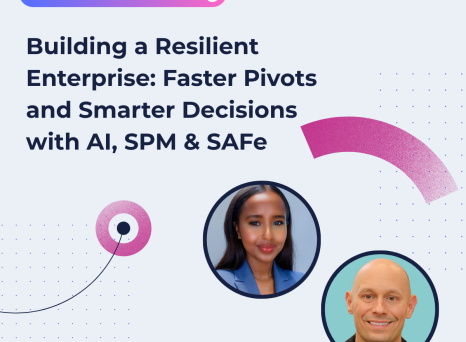The COVID-19 pandemic exposed significant weaknesses in global supply chains. By the summer of 2020, 73% of supply chain leaders reported supplier footprint issues. This highlighted the need for a drastic change of approach, with 93 percent saying they planned to increase the resiliency of their supply chains in the coming years.
But the pandemic was far from the first indication that supply chains weren’t sufficiently robust. The pandemic was just the latest challenge in what S&P has called a “decade of disruption” for global supply chains.
This raises the question: could businesses have been better prepared if they had learned the lessons of these earlier disruptions? And if so, how could they have achieved this?
Project portfolio management (PPM) processes are part of the answer. The PPM methodology helps companies adopt a flexible, iterative approach to project design and execution. As a result, it can help you be more agile and resilient in managing and mitigating supply chain risks.
In this post, we’ll look at why a proactive approach to supply chain disruptions is valuable and how PPM processes can help you implement one.
The Effects of Supply Chain Vulnerabilities
A recent survey of project professionals found that global supply chain issues were the second most common concern for the future. And given the far-reaching impact these issues can have, this should come as no surprise.
Supply chain vulnerabilities can lead to:
- Late delivery. Only 34% of organizations say they mostly or always complete projects on time, and supply chain disruptions are key in keeping that number low. Ultimately, you're unlikely to hit your deadlines if you don’t have materials and resources on hand when you need them.
- Poor-quality products. If your existing supplier networks can’t deliver, you may need to seek alternate sources to prevent costly shutdowns. But with speed paramount, it can be difficult to maintain quality assurance. And this is even more of an issue further upstream. After all, your suppliers might be facing their own procurement issues. Do you have the visibility you need to ensure quality is being maintained at your tier-two or -three suppliers?
- Overstretched budget. Supply chain disruptions won’t just add to your procurement costs — delivery delays and production shutdowns can also significantly increase your resource costs. Suddenly, your carefully planned budget starts to look like wishful thinking. The post-pandemic shortage of semiconductor chips is an excellent recent example, with spiraling lead times costing firms tens of billions of dollars.
- Operational inefficiencies. Successful project management requires effective cross-team coordination. But if supply chain issues cause your manufacturing team to miss deadlines, you may find other teams have allocated resource to work that can no longer go ahead. Suddenly, you have teams that can’t progress with their tasks while others are overwhelmed.
Each of these effects is a cause for concern. In concert, they can spell disaster for project delivery.
And it’s important to note that, in our densely interconnected world, even remote events can cause significant issues.
Local Challenges With Global Impact: The Case of the Fukushima Disaster
One of the reasons supply chain disruptions are such a concern is that even seemingly localized events can have global repercussions. And nothing shows this more clearly than the 2011 Fukushima nuclear disaster.
Triggered by the Tōhoku earthquake, the accident spilled radioactive material across northeastern Japan. This region is a manufacturing hub for many of Japan’s largest automotive companies, including Honda, Toyota, and Nissan. In the aftermath of the disaster, roughly 500 suppliers were put out of action.
Naturally, this affected Japan’s domestic car production. Toyota’s output dropped by 74% in April, and Honda’s by 81%. But parts manufactured in northeastern Japan weren’t just used by Japanese manufacturers. The global automotive industry relied on Japan for many of the approximately 30,000 parts that go into the average vehicle.
As a result, the disruption quickly spread across the globe. In one telling example, French factories owned by Peugeot Citroën and Opel — some 6000 miles from the disaster zone — found themselves operating at as little as 40 percent capacity due to a shortage of sensors manufactured by Hitachi.
The fact that a localized incident caused such widespread disruption led to a reckoning in the automotive industry. The “just-in-time” supply chain principles that had been dominant since the 1980s — and which prioritized efficiency over resiliency — were reconsidered. As a result, manufacturers like Toyota were better prepared than most for the semiconductor shortage of the past few years.
5 PPM Processes To Help You Overcome Supply Chain Disruptions
More than a decade after Fukushima, balancing cost concerns against the ability to manage disruption remains a challenge. But it’s one that PPM processes can help you to navigate.
Let’s look at five key processes and see how they can make your organization more resilient:
1. Identify and Prioritize Valuable Projects
At the heart of PPM is a practice called “portfolio thinking”. At its root, this means approaching each project from the perspective of your whole portfolio rather than in isolation. This enables you to identify your most valuable projects, as well as those that have logistical priority. These projects should be your focus when taking measures to protect your supply chain — by diversifying suppliers, for instance, or strengthening your supplier relationships.
2. Exercise Optionality
One of the lessons we can take from the “decade of disruption” is that, in planning projects, we should expect the unexpected. Accepting that some form of disruption is inevitable, we can prepare ourselves more effectively. And that’s exactly what optionality entails. Optionality means approaching projects with adaptability in mind and ensuring you have various options for how to proceed at any point. As a result, if circumstances change — you encounter supply chain delays, for instance — you can quickly reconfigure your approach.
3. Enable Cross-Functional Teams
If you’re going to exercise optionality, you need to have teams that can adapt quickly to changing priorities. And that means taking a cross-functional approach.
If critical skills are siloed in a particular team, you may not have the relevant knowledge to react at pace. Instead of implementing a solution, you’re trying to arrange meetings, share best practices, or chase for replies to urgent questions.
If your teams have a balance of strategic and technical skills across different competencies, they won’t need to wait. Instead, they can develop and execute contingency plans rapidly — and perhaps give you an advantage over your competition.
4. Combine Risk Management with Risk Mitigation
A robust risk management plan is an essential part of PPM. It involves anticipating the risks facing a given project and how those risks can have a cascading impact across your portfolio. If supply chain issues put one project’s deadlines at risk, how does this affect resource allocation for concurrent projects?
While having a plan to manage risk is important, so too is proactively identifying ways to mitigate it. You may not be able to prevent a disaster like the Fukushima accident from occurring, but you can build a supply chain infrastructure that avoids single points of failure. This will make you less susceptible to unexpected disruptions in the first place.
5. Implement a PPM tool
Each of the above processes has substantial advantages for tackling supply chain disruptions. However, applying them all across your project portfolio can be daunting, particularly because you’ll want to ensure consistent application across your organization.
A PPM tool like Planisware can help you adopt PPM processes in a consistent and streamlined fashion. All of your teams will have tools to help plan budgets, allocate resources, and track progress across your portfolio. If — or when — disruption does strike, you’ll be well prepared to act.





